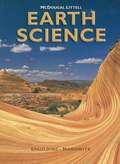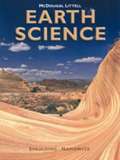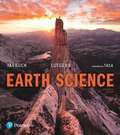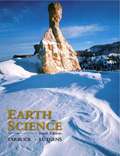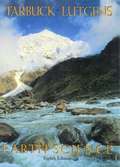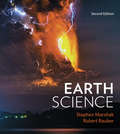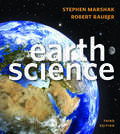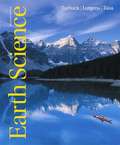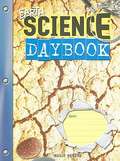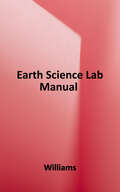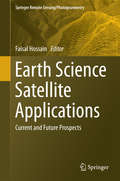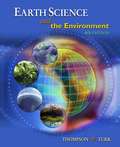- Table View
- List View
Earth Science
by Nancy E. Spaulding Samuel N. NamowitzEarth Science offers chapters on Investigating Earth, Earth's Matter, Dynamic Earth, Earth's Changing Surface, Atmosphere and Weather, Earth's Oceans, Space and Earth's History, in addition to links to scientific data, interactive visualizations, earth science news, and information on earth science in your region.
Earth Science
by PearsonEarth Science, 13th Edition, is designed for an 11th or 12th grade course in Earth science. It consists of seven units that emphasize broad and up-to-date coverage of basic topics and principles in geology, oceanography, meteorology, and astronomy. The book is intended to be a meaningful, nontechnical survey for students. In addition to being informative and up-to-date, Earth Science, 13th Edition strives to meet the need for a readable and user- friendly text and a highly usable "tool" for learning basic Earth science principles and concepts.
Earth Science
by Tarbuck Lutgensarth Science answers the need for a straightforward text that excites readers about the world around them. Perfect for individuals with little-to-no background in science, the text covers geology, oceanography, meteorology, and astronomy clearly and without technical jargon. Tarbuck, Lutgens, and Tasa are praised for their uncomplicated writing, dynamic media that help visualize physical processes, stunning art program that brings the “wow” factor, and valuable activities in Mastering Geology that provide activity-based learning to solidify readers’ understanding. The 15th Edition incorporates the latest data and applications from Earth Science, new data analysis activities, and an updated dynamic mobile media and Mastering Geology program.
Earth Science
by Utah Oer DoeWritten by a group of Utah teachers, this book focuses on the Utah State Science Standards for Earth science.
Earth Science (10th Edition)
by Edward J. Tarbuck Frederick K. Lutgens"Earth Science" offers a reader-friendly overview of our physical environment for the reader with little or no exposure to science. The emphasis is on readability, with clear explanations and examples, superb illustrations by the renowned Dennis Tasa, and an incredible collection of full color photographs and topographical maps. Topics covered in this highly readable and interesting book are geology, oceanography, astronomy, and meteorology. For readers needing a basic informational book about Earth Science.
Earth Science (California Edition)
by Holt Rinehart WinstonYou are about to take a journey through the world of Earth science. While different scientists study many different things, they each encounter questions and problems that they try to answer and solve. Earth scientists must often rely on indirect measurements using tools to sense things that are beyond the reach of their own five senses.
Earth Science (Eighth edition)
by Edward J. Tarbuck Frederick K. LutgensThe latest edition (fifth was 1988) of a broad and non-quantitative survey at the introductory level of topics in geology, oceanography, meteorology, and astronomy.
Earth Science (Second Edition): The Earth, The Atmosphere, And Space
by Stephen Marshak Robert RauberThe best text for helping students see the world around them through a scientist’s eyes Whether hiking along a mountain trail, driving down a highway, or making a decision about their energy usage, instructors want their students to see and assess the physical world they live in with more informed eyes. Through the most contemporary and applied text and the most vibrant visuals, Earth Science, Second Edition gets students leaving the class with a richer understanding of the science behind the physical world around them, and why it matters in their everyday lives. This purchase offers access to the digital ebook only.
Earth Science (Third Edition): The Earth, The Atmosphere, And Space
by Stephen Marshak Robert RauberIntroducing the exciting science of earth systems Leading authors in their respective fields, Stephen Marshak (physical geology) and Robert Rauber (atmospheric science) bring decades of teaching and research experience to this remarkable textbook and media package.?Earth Science, Third Edition, connects today’s learners with the science of earth systems. Accessible explanations, extraordinary visuals, and rich, versatile media resources help students appreciate how earth science matters in their lives, communities, and careers.
Earth Science (Thirteenth Edition)
by Edward J. Tarbuck Frederick K. LutgensEarth Science, Thirteenth Edition, is a college-level text designed for an introductory course in Earth science. It consists of seven units that emphasize broad and up-to-date coverage of basic topics and principles in geology, oceanography, meteorology, and astronomy.
Earth Science 2019, Grades 6-8 (HMH Florida Science)
by Houghton Mifflin HarcourtHMH Florida Science Student Edition Grades 6-8 Earth 2019
Earth Science 2: What Makes the Weather Change? (IQWST)
by Joseph Krajcik Brian ReiserNIMAC-sourced textbook
Earth Science Florida 2006
by Mead A Allison Arthur T Degaetano Jay M PasachoffScience textbook for high school students
Earth Science Laboratory Manual
by Harry Williams Kent McGregor Ken Iles George Maxey Lisa Nagaoka Alexandra Ponette-GonzalezThis Earth Science Laboratory Manual is meant to supplement and reinforce lecture material by giving you an opportunity to apply what you learn in class through hands-on activities. <p><p>The exercises illustrate some of the fundamental principles of earth science using a mixture of hypothetical data sets, data from scientific publications and data collected locally from the North Texas region. The exercises emphasize a hands-on, quantitative approach, supplemented by a web-based virtual field trips and CD-ROM exercises.
Earth Science Satellite Applications
by Faisal HossainThe combined observational power of the multiple earth observing satellites is currently not being harnessed holistically to produce more durable societal benefits. We are not able to take complete advantage of the prolific amount of scientific output and remote sensing data that are emerging rapidly from satellite missions and convert them quickly into decision-making products for users. The current application framework we have appears to be an analog one lacking the absorption bandwidth required to handle scientific research and the voluminous (petabyte-scale) satellite data. This book will tackle this question: "How do we change this course and take full advantage of satellite observational capability for a more sustainable, happier and safer future in the coming decades?"
Earth Science [Grade 3] (National Geographic Science Ser.)
by Randy Bell Malcolm B. Butler Kathy Cabe TrundleNIMAC-sourced textbook
Earth Science and Applications from Space: A Midterm Assessment of NASA's Implementation of the Decadal Survey
by Committee on the Assessment of NASA's Earth Science ProgramUnderstanding the effects of natural and human-induced changes on the global environment and their implications requires a foundation of integrated observations of land, sea, air and space, on which to build credible information products, forecast models, and other tools for making informed decisions. The 2007 National Research Council report on decadal survey called for a renewal of the national commitment to a program of Earth observations in which attention to securing practical benefits for humankind plays an equal role with the quest to acquire new knowledge about the Earth system. NASA responded favorably and aggressively to this survey, embracing its overall recommendations for Earth observations, missions, technology investments, and priorities for the underlying science. As a result, the science and applications communities have made significant progress over the past 5 years. However, the Committee on Assessment of NASA's Earth Science Program found that the survey vision is being realized at a far slower pace than was recommended, principally because the required budget was not achieved. Exacerbating the budget shortfalls, NASA Earth science programs experienced launch failures and delays and the cost of implementing missions increased substantially as a result of changes in mission scope, increases in launch vehicle costs and/or the lack of availability of a medium-class launch vehicle, under-estimation of costs by the decadal survey, and unfunded programmatic changes that were required by Congress and the Office of Management and Budget. In addition, the National Oceanic and Atmospheric Administration (NOAA) has made significant reductions in scope to its future Earth environmental observing satellites as it contends with budget shortfalls. Earth Science and Applications from Space: A Midterm Assessment of NASA's Implementation of the Decadal Survey recommends a number of steps to better manage existing programs and to implement future programs that will be recommended by the next decadal survey. The report also highlights the urgent need for the Executive Branch to develop and implement an overarching multiagency national strategy for Earth observations from space, a key recommendation of the 2007 decadal survey that remains unfulfilled.
Earth Science and the Environment (Fourth Edition)
by Graham R. Thompson Jon TurkUsing two themes, earth systems and environmental issues, EARTH SCIENCE AND THE ENVIRONMENT provides a rich overview of all Earth-related disciplines, including geology, meteorology, hydrology, oceanography, and astronomy. The authors provide a sense of how Earth functions as a single system composed of interacting subsystems and integrates coverage of enviromental issues in both the authoritative narrative and stunning multi-part visuals that emphasize the beauty of Earth science. To further enrich your experience, this earth science textbook is fully integrated with the CengageNOW online tutorial system. Web-based, assessment-driven, and completely flexible, the system provides you with a personalized learning plan based on a diagnostic pre-test to maximize your study time by focusing your attention where it is needed most.
